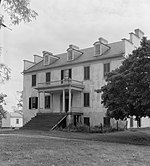Sunnyside Farm (Leetown, West Virginia)
Colonial Revival architecture in West VirginiaEastern Panhandle Registered Historic Place stubsFarms on the National Register of Historic Places in West VirginiaHistoric districts in Jefferson County, West VirginiaHistoric districts on the National Register of Historic Places in West Virginia ... and 6 more
Houses completed in 1899Houses in Jefferson County, West VirginiaHouses on the National Register of Historic Places in West VirginiaNRHP infobox with nocatNational Register of Historic Places in Jefferson County, West VirginiaUse mdy dates from August 2023
Sunnyside Farm is a farm near Kearneysville, West Virginia, United States, that is principally associated with William Fulk's dairy farming operation. The farm has a full complement of buildings associated with dairying, including the main house (1914), smokehouse (1914), milk house (C.1899). a small log house, chicken house (1920), garage (1920), tenant house (1920), hog shed (c.1915), pig house (c.1899), barn (1911, reconstructed after a fire in 1985) and silo (1911).
Excerpt from the Wikipedia article Sunnyside Farm (Leetown, West Virginia) (License: CC BY-SA 3.0, Authors).Sunnyside Farm (Leetown, West Virginia)
William Fulk Lane,
Geographical coordinates (GPS) Address Nearby Places Show on map
Geographical coordinates (GPS)
| Latitude | Longitude |
|---|---|
| N 39.37419 ° | E -77.90888 ° |
Address
William Fulk Lane 202
25430
West Virginia, United States
Open on Google Maps





